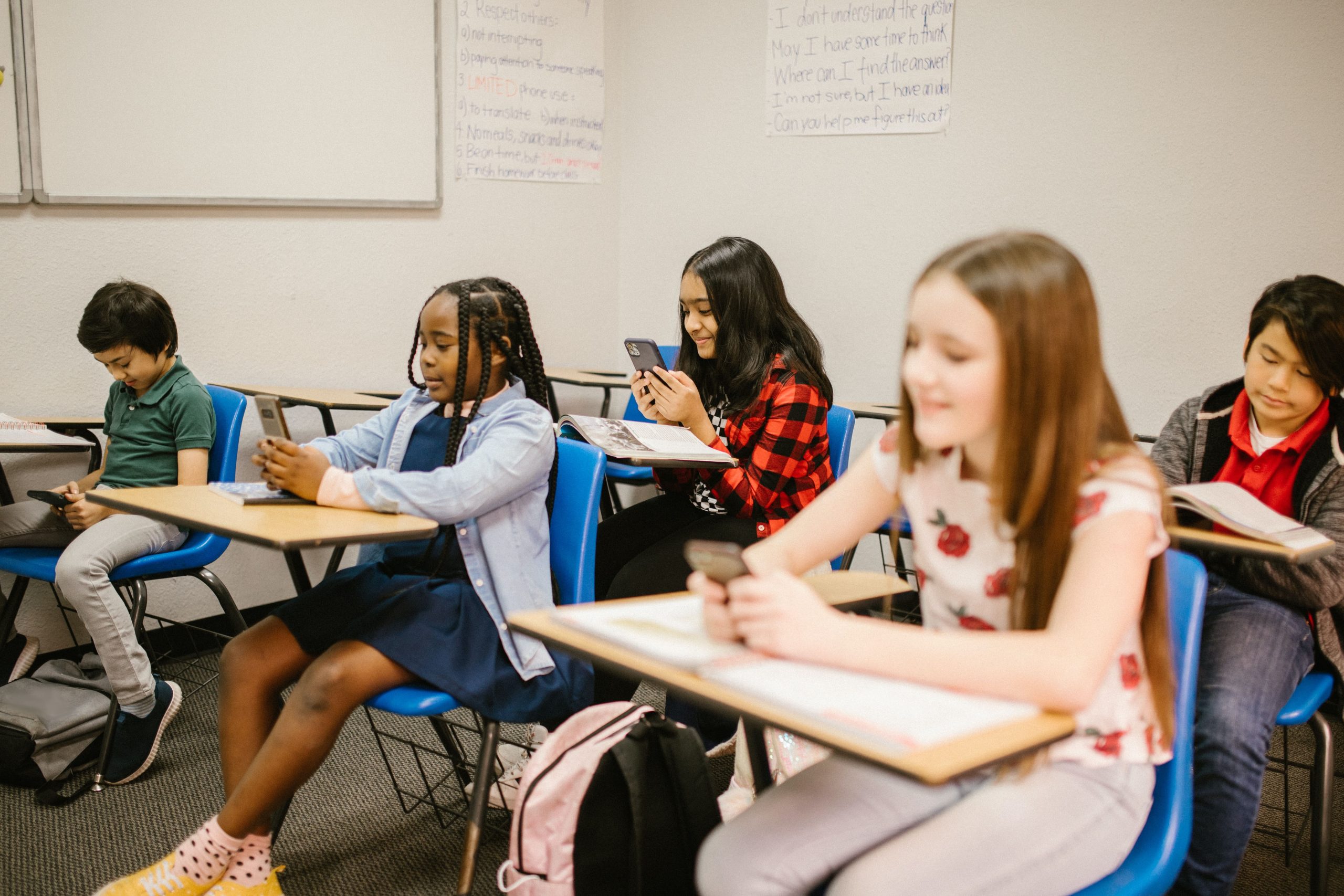In recent years, mobile apps have become increasingly popular in the education sector. And, there’s no signs of slowing: a recent study shows that the education apps market is projected to reach $101B by 2028, up from $37B in 2021. These apps offer a wide range of benefits that can enhance the learning experience for both students and educators. As we delve into the topic, let’s take a closer look at the rise of mobile apps in education and take a brief look at the history of educational apps.
The Rise of Mobile Apps in Education
Mobile apps have revolutionized the way we consume and access information. Similarly, the education sector has seen a marked increase in the use of mobile apps in recent years. With the widespread availability of smartphones and tablets, students and educators have access to educational resources and materials on the go. This accessibility has opened up new opportunities for learning and offers a more flexible approach to education.

A Brief History of Educational Apps
The early days of educational apps were mainly limited to drill and practice exercises, flashcards, and basic games. However, with advancements in technology, educational apps have evolved to offer a wide range of interactive and engaging learning experiences. From math and language apps to science and history, there’s an app for almost every subject.
One of the earliest educational apps was the “Speak & Spell” game, which was introduced by Texas Instruments in the late 1970s. The game helped children learn spelling and pronunciation by using a speech synthesizer. In the 1990s, educational software became more widely available on personal computers. However, it wasn’t until the rise of smartphones and tablets that educational apps truly took off.
Today, educational apps are used by students of all ages and levels, from preschoolers learning their ABCs to college students studying for exams. Many apps are designed to be fun and engaging, using game-like features to motivate students to learn. For example, the popular language-learning app Duolingo uses a points system and rewards to encourage users to practice their language skills every day.
The Growing Popularity of Mobile Learning
The benefits of mobile learning are numerous and have contributed to the growing popularity of educational apps. These benefits include:
- Increased engagement
- Improved motivation
- Higher retention rates
A more personalized and interactive learning experience is another impactful benefit as well. Additionally, mobile learning has also made education more accessible to learners who may have limited access to traditional educational resources.
Mobile learning can take many forms, from watching educational videos on YouTube to completing interactive quizzes on a mobile app. One popular example of mobile learning is the “flipped classroom” model, where students watch lectures or complete readings at home and then come to class to work on assignments and projects. This model allows for more personalized and interactive classroom time, as well as the flexibility to learn at one’s own pace.
Another benefit of mobile learning is that it can be done anytime, anywhere. Students can access educational materials on their smartphones or tablets while on the bus, waiting in line, or even during a break at work. This flexibility allows for a more integrated approach to learning, where education becomes a part of one’s daily routine rather than something that is done only in a classroom.
The rise of mobile apps in education has opened up new opportunities for learning and offers a more flexible approach to education. With the benefits of increased engagement, motivation, and accessibility, it’s no surprise that educational apps are becoming more and more popular among students and educators alike.
Enhancing Student Engagement and Motivation
Effective education is about more than just acquiring knowledge; it’s about engaging learners, making them enthusiastic about the subject matter, and motivating them to learn. Let’s explore several ways in which mobile apps can enhance student engagement and motivation.
Interactive Learning Experiences
One major benefit of educational apps is the interactive learning experiences they offer. Traditional education methods often rely on passive learning through lectures, but educational apps allow for real-time feedback and interaction. This can greatly enhance student engagement and motivation, making the learning experience more enjoyable and effective.
For example, an app that teaches math concepts could have interactive games that allow students to practice their skills in a fun and engaging way. The app could also provide instant feedback, letting students know if they got an answer right or wrong, and offering tips for improvement.
Gamification in Educational Apps
Another way in which mobile apps can enhance student motivation is through gamification. Educational apps that incorporate gamification elements, such as rewards, badges, and levels, can make learning seem like a fun challenge rather than a tedious task. This keeps students motivated and engaged throughout the learning process.
Imagine an app that teaches language skills, such as vocabulary and grammar. The app could have a points system where students earn points for completing lessons and quizzes, and can then use those points to unlock new levels or earn badges. This type of gamification can make learning a language feel like a game, keeping students engaged and motivated to continue learning.
Personalized Learning Paths
Finally, mobile apps can offer personalized learning paths that cater to individual learning styles and preferences. This customization ensures that the educational experience is tailored to the individual student, making learning more efficient and effective.
For example, an app that teaches history could ask students questions about their interests and then offer lessons and activities that align with those interests. If a student is interested in ancient Egypt, for example, the app could offer lessons on the pyramids and pharaohs. This type of personalized learning can help students feel more connected to the subject matter and more motivated to learn.
It’s clear mobile apps offer a variety of ways to enhance student engagement and motivation. Interactive learning experiences, gamification, and personalized learning paths are just a few examples of how educational apps can make learning more effective and enjoyable. By incorporating these elements into education, we can help students become more enthusiastic and motivated learners.
Improving Accessibility and Flexibility
Mobile apps in education are not only beneficial in terms of enhancing student engagement and motivation, but they can also improve accessibility and flexibility in education. In this section, we will explore several ways in which mobile apps can improve accessibility and flexibility.
Learning on the Go
One of the most significant benefits of mobile apps in education is the ability to learn on the go. Students no longer have to be confined to the classroom or library to learn; they can access educational resources wherever they are. This flexibility allows for a more personalized and efficient learning experience that fits into busy lifestyles.
For example, a student who has a part-time job or is an athlete can use mobile apps to learn during their downtime. They can watch educational videos, complete quizzes, and participate in discussions while waiting for a bus, during a break at work, or while traveling to a game or competition. This flexibility ensures that students can make the most of their time and learn at their own pace.

Bridging the Digital Divide
Mobile apps in education can also bridge the digital divide by providing underprivileged learners with access to educational resources they may not otherwise have had. This inclusivity ensures that learners from all backgrounds have the opportunity to access the same high-quality educational resources.
For instance, students from rural areas or low-income families may not have access to the same educational resources as their peers in urban areas or higher-income families. However, with mobile apps, these students can access educational materials, such as textbooks, videos, and interactive simulations, that they may not have been able to access otherwise. This can help level the playing field and ensure that all students have an equal opportunity to succeed.
Supporting Students with Special Needs
Mobile apps in education can provide additional support for students with special needs, such as those with visual or hearing impairments. With the use of assistive technologies, such as text-to-speech and audio descriptions, these learners can access educational content and interact with the learning materials like never before.
For example, a student with a visual impairment can use a mobile app that converts text to speech to read a textbook or an article. Similarly, a student with a hearing impairment can use an app that provides audio descriptions to understand a video or a lecture. These assistive technologies can help students with special needs overcome barriers to learning and participate fully in the educational experience.
Facilitating Collaboration and Communication
Mobile apps in education are not just for individual learners; they can also facilitate collaboration and communication. Here, we’ll explore several ways in which mobile apps can facilitate collaboration and communication between students and teachers as well as between peers.

Connecting Students and Teachers
Mobile apps can facilitate communication and collaboration between students and teachers outside of the classroom. Educational apps that offer messaging and chat features allow for communication that is instant, convenient, and private. This open line of communication can foster stronger relationships between students and teachers, leading to a more efficient and effective learning experience.
For example, a language learning app can have a messaging feature where students can ask their teacher for help with specific grammar rules or vocabulary. This feature allows students to get the help they need when they need it, without having to wait until the next class. Additionally, the messaging feature can be used for students to submit their homework or assignments, making it easier for teachers to grade and provide feedback.
There are also mobile apps like GRADED+ that allow teachers to streamline their workflow and quickly upload graded student work into their classroom database.
Peer-to-Peer Learning Opportunities
Mobile apps can also facilitate peer-to-peer learning opportunities. Educational apps that offer group activities and discussion forums provide opportunities for students to learn from each other. This type of collaborative learning can enhance the learning experience by promoting the sharing of ideas and fostering critical thinking skills.
For instance, a history learning app can have a discussion forum where students can share their insights on a particular event or period. This feature can encourage students to think critically about historical events and develop their analytical skills. Moreover, students can learn from their peers’ perspectives and gain a deeper understanding of the topic.
Parental Involvement in Education
Finally, mobile apps can foster parental involvement in education. By providing parents with access to educational resources and progress reports, educational apps can improve communication between parents and teachers. This collaboration ensures that everyone is on the same page and working together to support the success of the learner.

For example, a math learning app can have a progress report feature that allows parents to track their child’s progress in the subject. This feature can help parents identify areas where their child may need additional help and communicate with the teacher to develop a plan to support their child’s learning.
Mobile apps can facilitate collaboration and communication between students, teachers, and parents. These features can enhance the learning experience by providing students with the help they need, promoting critical thinking skills, and improving communication between stakeholders. As the use of mobile technology continues to grow, we can expect to see more innovative ways in which mobile apps can support education.
Conclusion
Mobile apps in education offer a wide range of benefits that can enhance the learning experience for both students and educators. From improving accessibility and flexibility to facilitating collaboration and communication, mobile apps are transforming the education sector like never before.



